Few films in history have as iconic an opening as Stanley Kubrick’s 2001: A Space Odyssey. It’s the kind of sequence that’s been positively baked into the subconscious of our culture. It’s been overexposed and parodied for decades now, to the point that its central brilliance often gets overlooked. In a single minute-and-a-half-long shot, Kubrick distilled and captured the narrative and thematic core of the film. Through its use of sound, lighting, and color, the sequence establishes the narrative drive and thematic motifs that make the entire film.
It begins with the low rumbling tones of Richard Strauss’ Also sprach Zarathustra. Iconic in its sounds and grandeur, this composition is named after Friedrich Nietzsche’s philosophical novel. In said novel, the great German philosopher explores concepts of space and time through the narrative lens of a story chronicling the adventures of Zarathusta. And while more controversial subjects touched on in the novel may often get more credit in terms of re-evaluated thematic weight, such as the infamous ‘God is Dead’ line, Nietzsche himself stated that the novel’s true goal was to illustrate the “eternal recurrence of the same”. And while Richard Strauss’ composition is named for the novel, it is important to note that the piece heard over the opening of 2001 is only the first section of the piece, subtitled Introduction, or Sunrise.
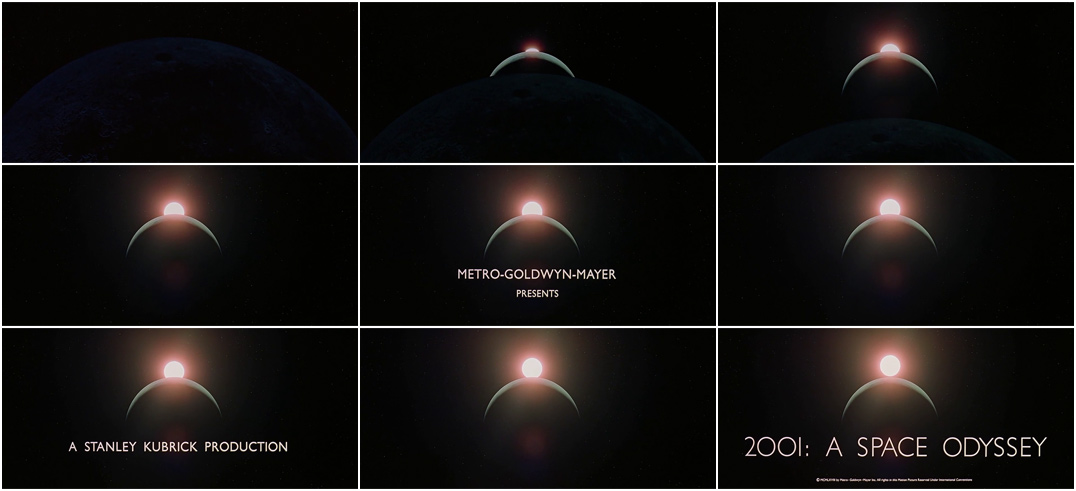
One can feel all of this weighing on the film’s opening sequence, gifting it with this tremendous depth and history through Kubrick’s use of associative thematics. As we watch the Moon give way to the Earth give way to the Sun, it is not only brilliant in cinematic composition but also in its clarity. Through the use of visual and audio cues, sunlight is immediately established as one of the film’s primary motifs. On a visual level, the sun is the brightest element in the frame. It is the only light source visible and as the camera pulls upwards, it is literally what brings the world into existence for the audience. Much like the dawn of man itself, the sun’s dawning is what brings creation for the film as well. On an audio level, Kubrick times Strauss’ most bombastic crescendo and accent to coincide with both the title of the film appearing on-screen and the full reveal of the Sun.
Throughout the film, sunlight remains of great importance. The Dawn of Man sequence literally opens with several unbroken minutes of long takes of the Sun and land in which the hominids live. It’s an entrancing choice that not only pulls the audience into the world on-screen through the use of these incredibly beautiful still-photographs but also through the subtle building of a sonic world through sound design all around them. It encourages the audience to not only understand but to meditate on the relationship between Earth and the Sun. It is simultaneously what brought life to Earth in the first place, yet it is also what causes the drought, leaving only the one watering hole that the various factions of hominids must fight over.
In the watering hole sequences, the hominid factions are covered in shade, symbolizing their relative ignorance, while the water itself is illuminated by sunlight. They are divided by intelligence, by evolution itself. As an extension of this, the same is true when the Monolith appears to them. They are all covered in shade and darkness, yet the Monolith is awash in sunlight. It is their intelligence, their evolution.
It is from their interaction with this Monolith that they learn to use bones as weapons, which allows them to better provide food for their family and faction. But here too, with beauty comes death. And tellingly, the moment that the hominid turns on his fellow hominid in an act of violence is once again set with all of them darkened by the shade, right up until the two of them step forward into the glow of the sunlight to actually commit the murder. They have gained intelligence, they have evolved, but at what cost?
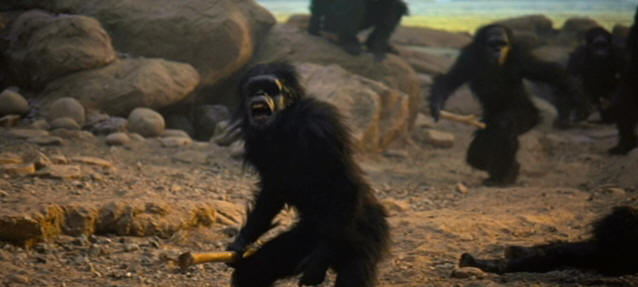
This is what makes the iconic century-spanning cut from bone to space station such an affecting moment. It establishes an immediate correlation between the weapon and violence of the hominids and the technology of the future. As the Blue Danube-scored docking sequence unfolds, the visuals are balletic in form. The audience is introduced to the wonders of the future, all of which is aglow in the warmth of the sunlight. Even smaller moments, like Heywood Floyd’s floating pen being grabbed by the stewardess, are carefully constructed to fill with wonder. Just as the stewardess enters the cabin, the glow of the sunlight runs up the side of Floyd’s pen, reaching the top just as she enters.
But it is once we enter the inside of the Space Station 5 that things get really interesting. Here, even though there are several windows looking out into space, Kubrick never shows sunlight. Instead, where the space that was formerly occupied in-frame by the Sun is now occupied by the Earth. And the lighting has shifted from the glow of sunlight to the colder, whiter glow of man-made light sources within the ship.
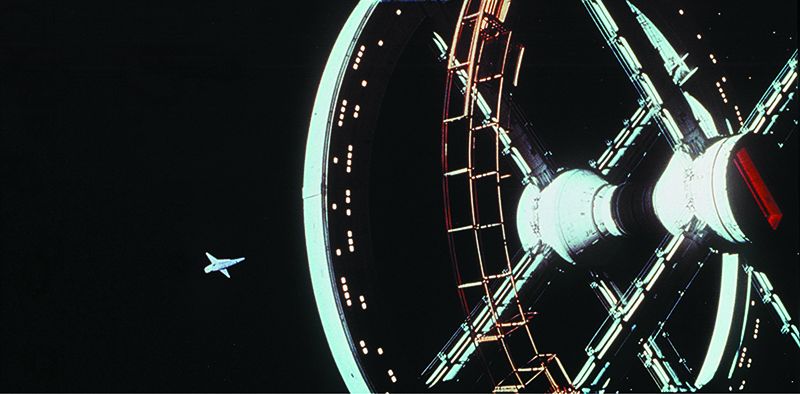
Rather than receiving the intelligence or evolution of the sunlight, the people of the future have crafted their own light. And rather than worshiping the Sun as hominids did, they worship themselves and their own technology, which is why the Earth has taken the Sun’s place in Kubrick’s framing.
As he uses white to symbolize man-made structure, Kubrick also uses another color to symbolize the impending danger of man’s evolutionary track: bright, blood red.
The first inclusion of red in the entire film is during The Dawn of Man sequence, in which the meat that the hominids are able to procure because of their use of weapons is fittingly blood red, acting as foreshadowing for what is to come. The color becomes increasingly pronounced as the film goes on. During the docking sequence, the underbelly of the Space Station 5’s dock is lit entirely in this shade of red. Similarly, inside of the Space Station, all of the tables are white on top with red legs holding them up underneath. This creates a sense of unease in the viewer, conscious or not, because of the correlation Kubrick is forcing us to realize. Even in man’s greatest accomplishments, that danger has always been present. To take it even one step further, all of the chairs on the Space Station are this shade of red as well. In man’s comfort, in their endless quest to take the path of least resistance, they have only brought about more harm and destruction.

Once Floyd gets to Clavius Base, this is all taken to an even more direct level. In one of the film’s most striking shots, his ship lands on the surface of the base before descending into the blood-red belly of the station itself. During the briefing scene, the room is lit by each wall having a massive white-light force on each side. It is a room full of the top intelligence officers and it is drowning not in sunlight, but in man-made light. Tellingly, the only section of the room that isn’t drowning in light are the corners, which are lined with black. In one of these corners is the American flag, properly symbolizing how the country and its people are being left in the dark just as the hominids once were. But whereas the hominids were left in the dark by a higher power, mankind is now being left in the dark by its fellow man. This sequence also features several great shots that feature Floyd standing with the flag as Kubrick hauntingly goes out of his way to foreground the colors of the majority of the flag: white and red.
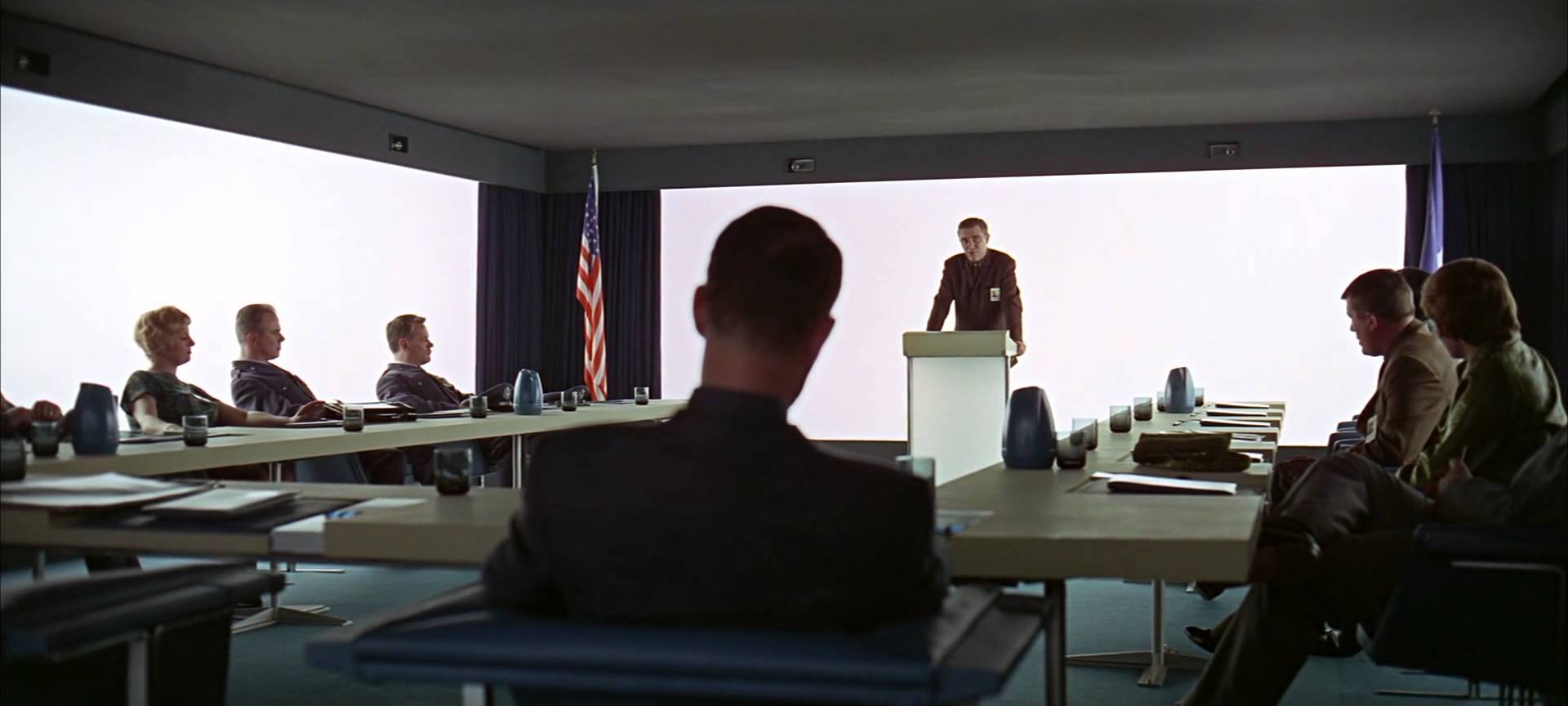
When the team then travels to the other side of the Moon to see the Monolith that has appeared, it is fittingly not touched by sunlight this time, but rather solely illuminated by man-made light structures. From here, the film cuts to its next sequence, the voyage of the Discovery One.
Onboard the Discovery One, we get the film’s most direct statement on the color red and its meaning in the form of HAL and his blood-red eye. HAL is the epitome of man-made technology, whose rectangular black interface bears a striking resemblance to that of the Monolith itself. It is mankind’s attempt at creating intelligence, at creating their own form of evolution.
Inevitably, this backfires on them. HAL’s intelligence is unable to be confined to the paths its makers deem appropriate. And once again, this evolution’s dire consequences are cemented by an act of violence, as he murders Frank. As a result, David is forced to go into the bowels of HAL’s system in order to unplug him. The inside of HAL’s processor core features a room entirely lit in the same shade of blood-red and the banks of files which power HAL’s higher functions shine bright white. As David pulls them out, taking the intelligence away from HAL, they light up David’s face as if he is gaining knowledge. And of course, it is only after completing this task that he is granted with knowledge as a video from Dr. Floyd appears and tells him the purpose of the entire mission.
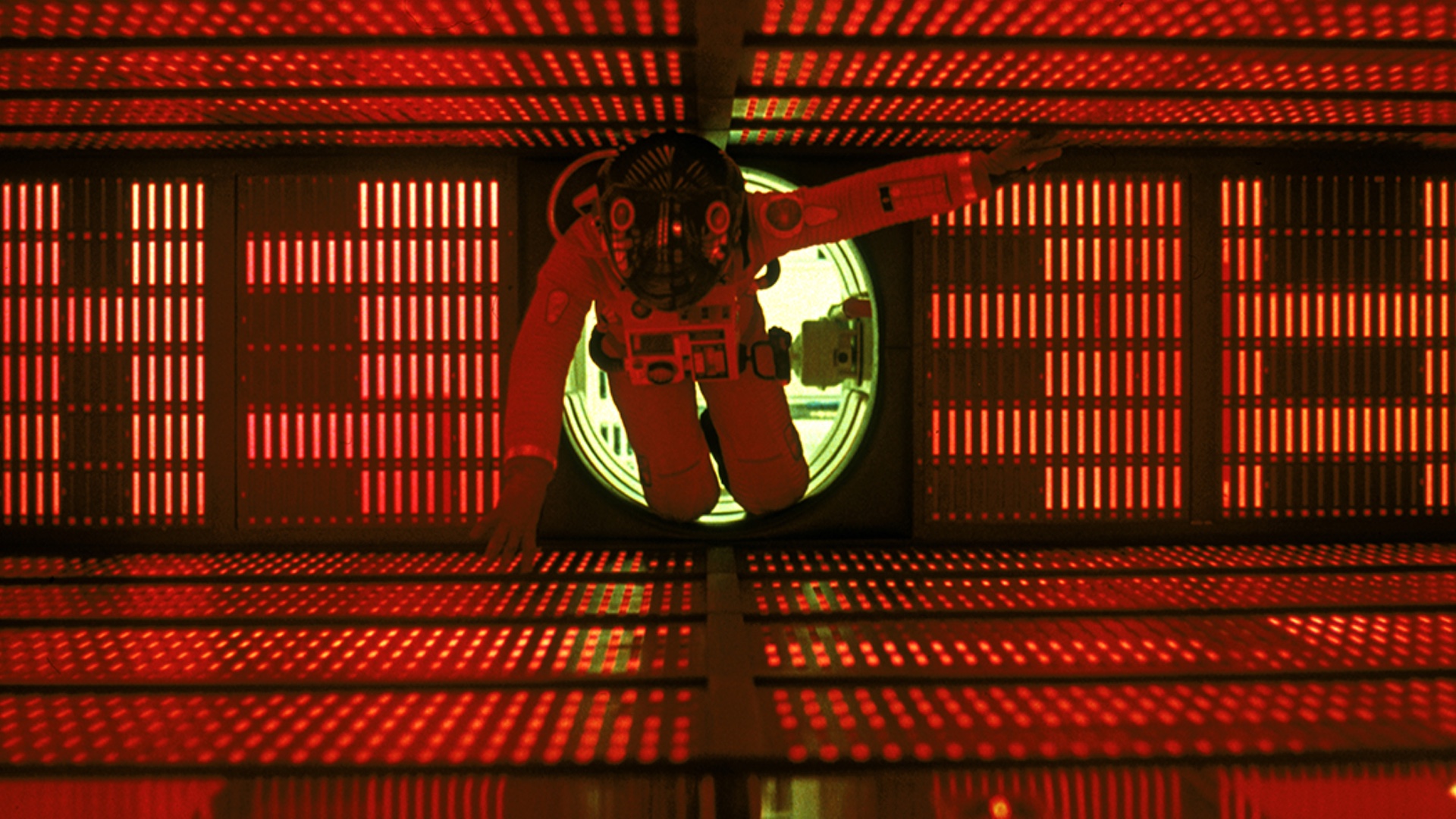
The final sequence of the film, Jupiter and Beyond the Infinite, capitalizes on all of this to deliver something truly mesmerizing. As David arrives, Kubrick’s camera pans up to reveal Jupiter bathing in the sunlight. But brilliantly, the shot also shows all of the moons of Jupiter and foregrounds all of the shining stars piercing through the darkness. Our Sun is not the only source of life or intelligence in the world, there are infinite sources out there and that is the point. To see the universe through a man-made lens is to misunderstand it. Which is exactly what David learns in the Stargate sequence, through Kubrick pushing color theory, cinema vérité, and the form of film as a whole to its very limits.
The final moments of the film see David being granted an entirely new kind of intelligence by the Monolith. The shot pushes forward into the Monolith, being engulfed by the abyss before suddenly cutting back to a shot of the Moon. Richard Strauss’ Also sprach Zarathustra cues up one last time as a bright light begins to fill the screen and the camera pans down, revealing its glow on the Earth and the Moon, as David as the Star Child enters the frame. Now he is the Sun, he is the intelligence and evolution.
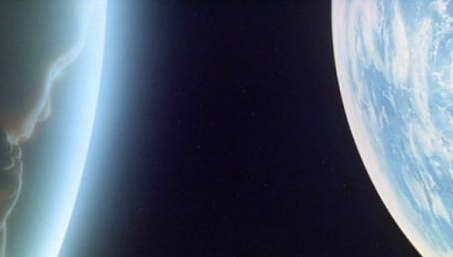
And it is just as Nietzsche said; an “eternal recurrence of the same”.